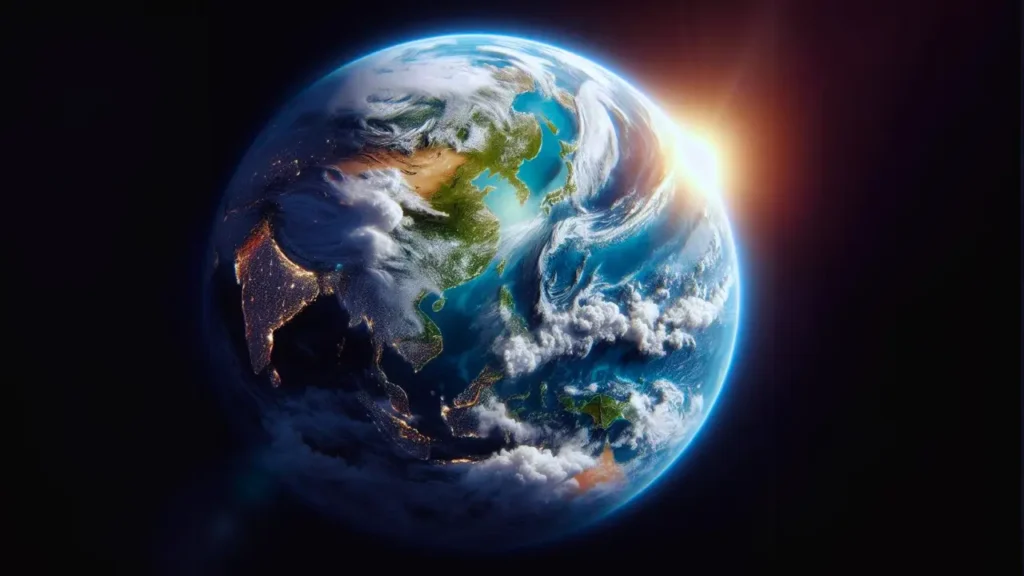
Understanding the speed at which Earth spins involves considering factors such as its rotation time and circumference. While a solar day, defined by the time it takes for the sun to reappear in the same position in the sky, is 24 hours, a sidereal day, which represents one full rotation of Earth concerning distant stars, is 23 hours, 56 minutes, and 4.091 seconds.
The critical factor in determining Earth’s rotational speed is its circumference. At the equator, where the circumference is approximately 40,075 kilometres, Earth spins at around 1670 kilometres per hour. However, this speed is unique globally. Moving towards the poles reduces the circumference, leading to a slower rotational speed until it reaches its minimum at the poles. It’s worth noting that Earth orbits the sun at a staggering 107,000 kilometres per hour.
If we travel so fast through space, why can’t we feel it?
Despite Earth’s rapid motion through space, the rotational speed is constant, making it invisible to inhabitants. Analogously, it’s akin to driving a car at a constant speed, where the motion is only noticeable when there’s a change in speed. Earth’s rotational speed has changed over millions of years, slowing down gradually. Factors such as ocean currents, tides, and wind create friction on the surface, contributing to this deceleration. By altering sea levels and mass distribution, global warming could influence Earth’s rotation speed, impacting timekeeping technologies like atomic clocks and GPS systems.
What will happen if Earth stops spinning?
While the idea of Earth ceasing its spin is implausible without significant external forces, contemplating the scenario provides exciting insights. If Earth were to stop rotating, the atmosphere would persist in its rotational motion, resulting in powerful winds that could sweep away anything not anchored to the surface, including trees and buildings.
Without centrifugal force, each side of the planet would experience six months of continuous sunlight followed by six months of darkness. The oceans, lacking the rotational influence, would gradually shift towards the poles, forming a massive supercontinent around the equator. However, gravity and Earth’s centrifugal force keep everything grounded. To experience weightlessness, Earth would need to spin at an astounding speed of 28,437 kilometres per hour at the equator, lifting objects off into space.
READ MORE: Why do flamingos stand on one leg?
Why don’t we feel the Earth spinning?
The Earth’s constant rotational speed means everything, including us, moves at the same pace. Like driving in a car at a constant speed, the motion is not felt because it remains consistent. Sensation of motion occurs when there’s a change in speed.
What would happen if the Earth stopped spinning?
Without a significant external force, stopping Earth’s spin is impossible. However, if it were to happen, the atmosphere would continue to rotate, causing powerful winds that could sweep away unanchored objects. Each side of the planet would experience six months of continuous sunlight and darkness, and oceans would shift, forming a supercontinent around the equator.
Can we see Earth’s rotation from space?
Earth’s rotation is not visually apparent from space because the planet completes its rotation over a 24-hour period, making the change gradual and imperceptible from a distance.
Why don’t the stars move if the Earth is spinning?
The stars appear fixed from our perspective because Earth’s rotation is relatively slow compared to the vast distances of the stars. The apparent motion of stars is not noticeable within the timescale of a human lifetime.
Could humans survive if the Earth stopped spinning?
Surviving a sudden halt in Earth’s spin would be challenging. The resulting winds and environmental changes would have profound effects, making it inhospitable for most life forms.
3 thoughts on “How Fast Does Earth Spin?”